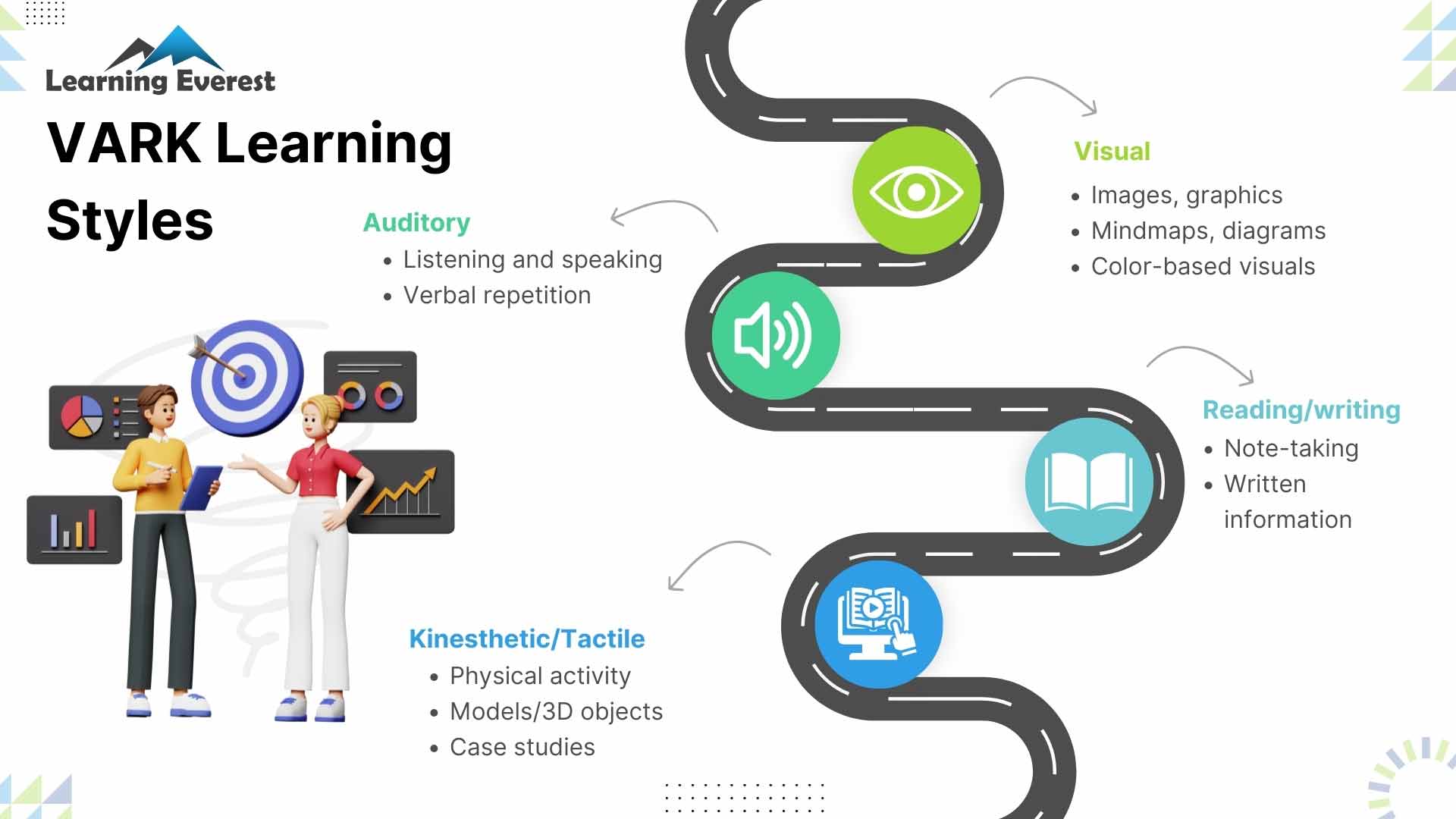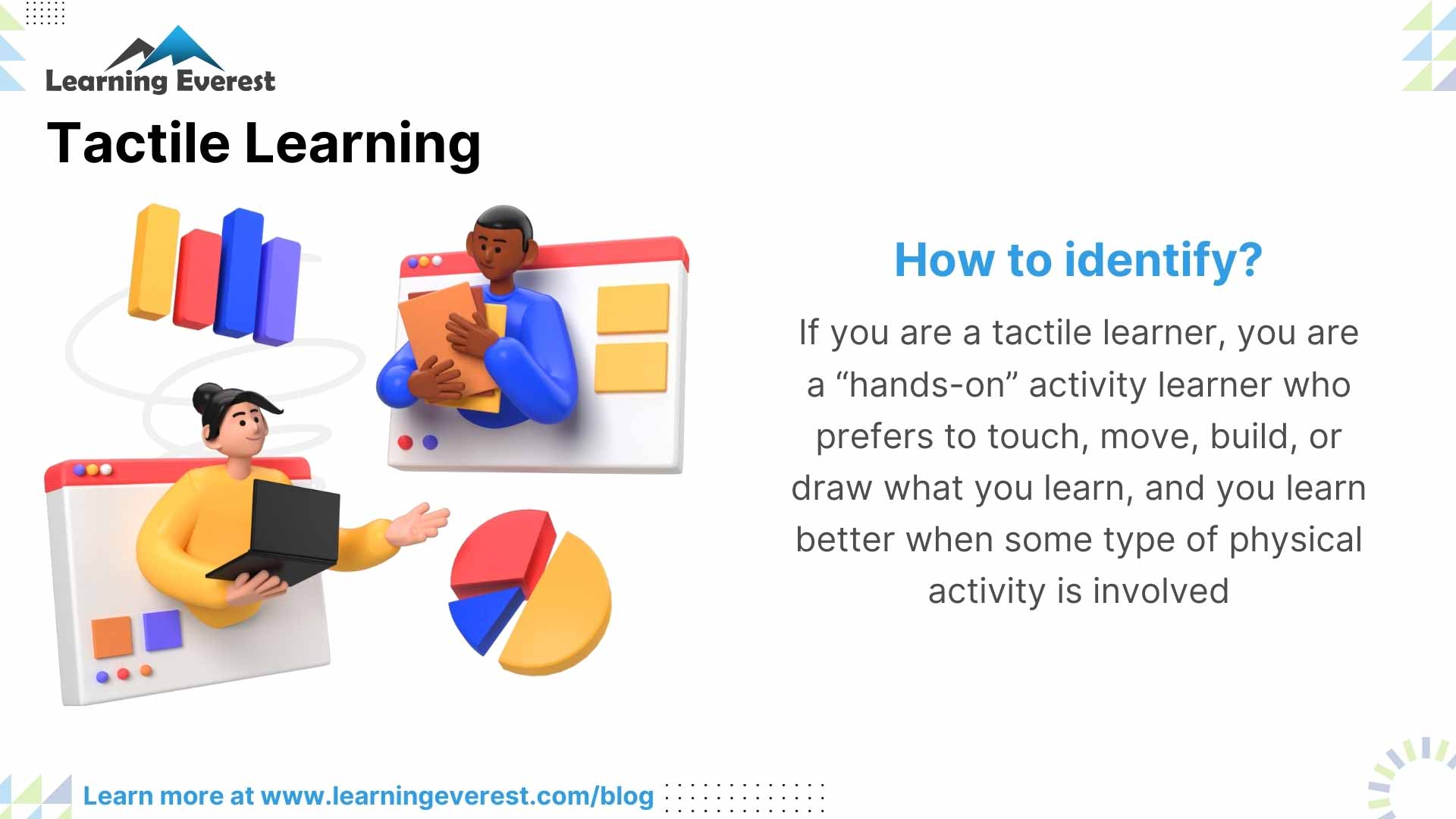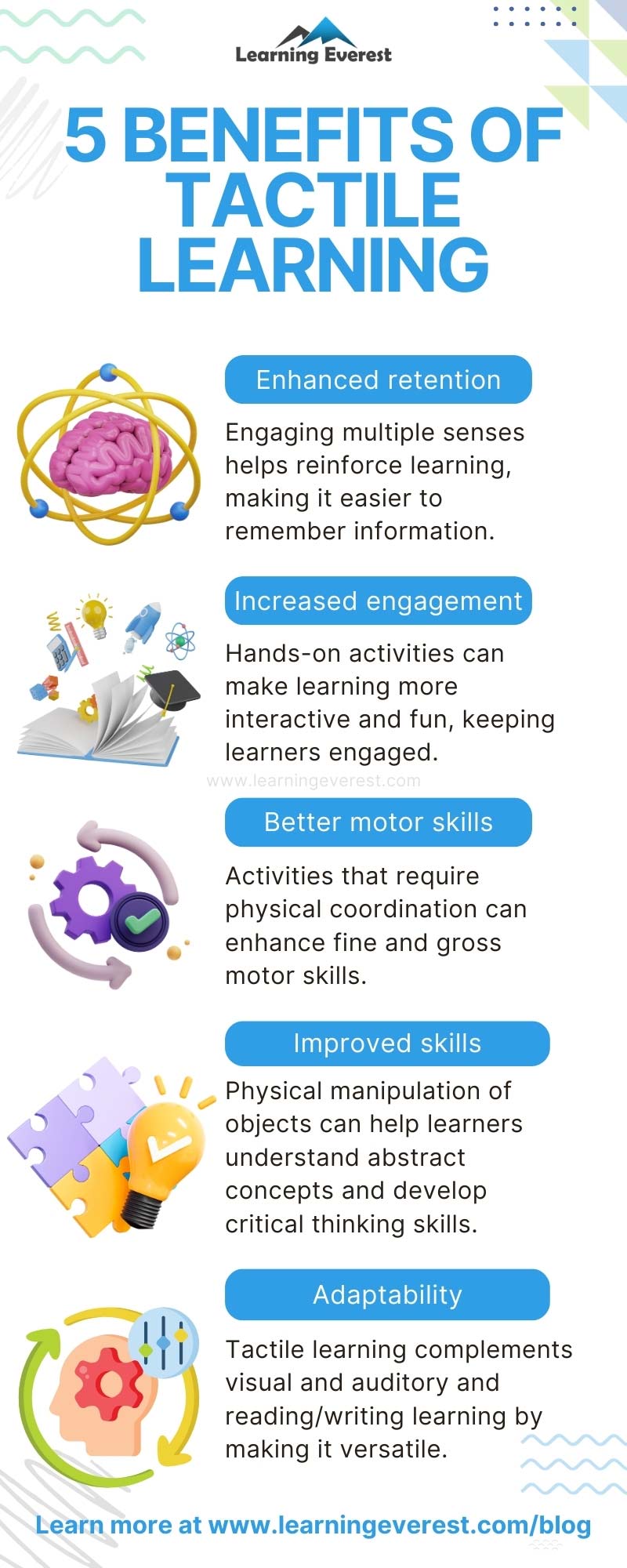The primary learning styles are auditory, visual, kinesthetic or tactile, and reading and writing. While every learner will likely use all of these learning styles in their education, most learners have a certain learning style that is more easy to them. Instructors can identify the different types of learning styles their learners utilize most, and then cater activities and traditional learning to help a wide variety of learners learn and grow. Ultimately, instructors want their learners to thrive while learning and understanding learning styles and how to incorporate them into a learning journey is key for that success.


Tactile Learning – Vark Learning Styles
What is tactile learning?
Tactile learners need to physically touch or practice something in order to learn the concept best. This learning style is often called multi-sensory or kinesthetic learning because tactile learners hear or see or do to learn, and then complete their learning by trying it out themselves.
This is very different from regular auditory, reading/writing and visual learning where learners need to see or hear or read instruction in order to learn it. If you are a tactile learner, you will prefer learning by touching and doing. You understand and remember things using physical movement. You are a “hands-on” activity learner who prefers to touch, move, build, or draw what you learn, and you learn better when some type of physical activity is involved.


Tactile Learning
Characteristics of Tactile Learning
Instructors can greatly benefit from figuring out what kind of learning style a learner prefers. This helps them to be able to connect with a learner in the best way for their learning, and allows them to try new techniques if a learner is struggling with a concept. There are a few ways an instructor can identify a tactile learner, including:
- Tactile learners often learn best when moving. Their sense of touch and ability to move around can actually help them comprehend and learn things better.
- Tactile learners enjoy hands-on activities. Learners who particularly enjoy participating in hands-on activities may be tactile learners.
- Remembers information better when they write it down. Tactile learners can often be identified as those learners who are focused on taking notes or writing in their planner as part of their learning.
- Ignores or overlooks instructions. Tactile learners may have trouble remembering or following instructions. If you have a learner who particularly struggles with following the rules, they may be a tactile learner.
- Dislikes feeling confined. Both physical and mental confinement can be a problem for tactile learners. If you have a learner who doesn’t want to think inside the box or has a problem with being in a small setting seated at their desk, they may be a tactile learner.
- Difficulty focusing for long periods of time. Tactile learners aren’t great at sitting still and listening or reading for a long period of time. They crave physical movement and are often good at physical activities. A learner who doesn’t want to sit still may be a tactile learner.
Tactile learning examples
Beyond learning what characteristics to look for, it is greatly beneficial for instructors to know what tactile learning looks like in action, helping them get ideas for how to use tactile learning activities in their learning process. Some of the examples of tactile learning include:


How to incorporate Tactile Learning
Let’s discuss them in detail.
1 – Roleplays/Simulations
Simulations can be used to assess the knowledge/skills, adapt instruction, and allow tactile learners to apply what they’ve learned. Computer simulations can offer an immersive learning environment, allowing tactile learners to experiment, make decisions, and observe outcomes in a controlled setting. These simulations can help learners think about difficult concepts and abstract ideas in a safe and cost-effective manner. An example would be that of a simulation of safety training, which lets learners interact with dangerous workplace situations virtually.
Such interactive approaches can also be personalized to each learners, empowering them to build knowledge networks and deepen their comprehension. The goal of this type of learning is to identify a solution or an answer to a real-world problem. Scenario-based learning can be used to give compliance training, soft skills training, professional skills training, leadership training, etc. A scenario-based learning environment is exceptional for keeping the learners engaged throughout their learning journey. It creates real experiences.
To learn more read our blog on How can you integrate scenario-based learning into your customer service training modules?
2 – Case study
Case studies can be presented in multiple ways, allowing tactile learners to respond to open-ended questions, brainstorm solutions, or examine facts. This method allows learners to compare their own thinking and strategies with those of the experts, providing them with the opportunity to achieve insight into the thought process behind solving the problem. Case studies demonstrate exactly what success looks like and give a model of the problem-solving process that learners can refer to. Having this model decreases the cognitive load on learners, allowing the learners to focus on understanding the process required to complete a task.
3 – Gamification
In tactile learning, gamification can be used as a dynamic tool, latching on to learners’ innate desire for challenge and reward. By integrating game-like elements, instructors can encourage engagement and foster creative collaboration. For example, leaderboards or achievement badges can motivate learners to delve deeper into topics, while collaborative games can strengthen networking and peer-to-peer learning. Instructors must strike a balance that ensures that learning is not overshadowed by game mechanics.
To learn more about gamification, read our blog on 5 Game Mechanics to Use in eLearning with Gamification Examples.
4 – Mentorship programs
As an instructor, it is extremely important to know how to encourage different learners so they can thrive while learning. Understanding what tactile learners need will help you be able to work with them and motivate them to find their own ways to focus. Mentorship programs support tactile learning by bringing together employees at different stages in their careers to swap internal knowledge and discuss case studies.
This can inspire others to perform better work or develop particular skills. Mentors can showcase success stories within your organization to inspire your employees and demonstrate how others have successfully navigated similar development paths before. They inspire healthy competition in the workplace. Those who work with them notice how well they perform, and it may inspire them to produce work on the same level or above their level. This atmosphere motivates everyone to place extra effort into their work and achieve new goals.
5 – Project-based learning
Self-directed project-based learning is a great tactile learning activity for so many reasons. Learners work together to investigate an authentic and nuanced real-world problem. This, of course, goes deeper than doing any old project. The motto is to get learners to engage with a question or critical challenge that requires concentration and nuanced problem-solving and critical-thinking skills. This question or challenge must:
- Be open-ended
- Encourage learners to apply skills and knowledge they’ve developed
- Allow learners to take their own approaches to develop an answer and deliver a product
They build curriculum-aligned skills in the process. They are rewarded with enhanced communication and problem-solving skills.
Do you like to learn about the VARK model in detail. Read our blog on The VARK Model: Explained.
Infographic


5 Benefits of Tactile Learning
Knowledge check!
Frequently Asked Questions (FAQs)
Q: What are the 4 types of learning styles?
A: Named the VARK model of learning, Neil D. Fleming theorized that we all have one of four main learning styles: visual, auditory, reading/writing, and kinesthetic/tactile learning.
Q: What is tactile learning?
A: Tactile learning style is often called multi-sensory or kinesthetic learning because this type of learner not only hears or sees or does to learn and then completes their learning by trying it out themselves.
Q: What is a tactile learning example?
A: Self-directed project-based learning is a great tactile learning activity for so many reasons. Learners work together to investigate an authentic and nuanced real-world problem.